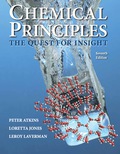
(a)
Interpretation:
Net ionic equation has to be written for the formation of precipitate and the spectator ions has to be identified in the reaction between
(a)
Explanation of Solution
The reaction given is between aqueous solutions of
Aqueous solution of
The balanced chemical equation for the reaction is given as follows:
Complete ionic equation is written by showing the ions present in aqueous solution. This is given as follows:
In the complete ionic equation, the common ions that are present on both sides of the equation is known as spectator ions. Thus in this case, the spectator ions are
Thus net ionic equation can be written as follows:
(b)
Interpretation:
Net ionic equation has to be written for the formation of precipitate and the spectator ions has to be identified in the reaction between
(b)
Explanation of Solution
The reaction given is between aqueous solutions of
Aqueous solution of
The balanced chemical equation for the reaction is given as follows:
Complete ionic equation is written by showing the ions present in aqueous solution. This is given as follows:
In the complete ionic equation, the common ions that are present on both sides of the equation is known as spectator ions. Thus in this case, the spectator ions are
Thus net ionic equation can be written as follows:
(b)
Interpretation:
Net ionic equation has to be written for the formation of precipitate and the spectator ions has to be identified in the reaction between
(b)
Explanation of Solution
The reaction given is between aqueous solutions of
Aqueous solution of
The balanced chemical equation for the reaction is given as follows:
Complete ionic equation is written by showing the ions present in aqueous solution. This is given as follows:
In the complete ionic equation, the common ions that are present on both sides of the equation is known as spectator ions. Thus all are spectator ions in the given equation.
As all the ions present in the ionic equation, there is no net ionic equation.
(d)
Interpretation:
Net ionic equation has to be written for the formation of precipitate and the spectator ions has to be identified in the reaction between
(d)
Explanation of Solution
The reaction given is between aqueous solutions of
Aqueous solution of
The balanced chemical equation for the reaction is given as follows:
Complete ionic equation is written by showing the ions present in aqueous solution. This is given as follows:
In the complete ionic equation, the common ions that are present on both sides of the equation is known as spectator ions. Thus in this case, the spectator ions are
Thus net ionic equation can be written as follows:
(e)
Interpretation:
Net ionic equation has to be written for the formation of precipitate and the spectator ions has to be identified in the reaction between
(e)
Explanation of Solution
The reaction given is between aqueous solutions of
Aqueous solution of
The balanced chemical equation for the reaction is given as follows:
Complete ionic equation is written by showing the ions present in aqueous solution. This is given as follows:
In the complete ionic equation, the common ions that are present on both sides of the equation is known as spectator ions. Thus in this case, the spectator ions are
Thus net ionic equation can be written as follows:
Want to see more full solutions like this?
Chapter F Solutions
EBK CHEMICAL PRINCIPLES
- Write the net ionic equation for the reaction, if any, that occurs on mixing (a) solutions of sodium hydroxide and magnesium chloride. (b) solutions of sodium nitrate and magnesium bromide. (c) magnesium metal and a solution of hydrochloric acid to produce magnesium chloride and hydrogen. Magnesium metal reacting with HCl.arrow_forwardIf aqueous solutions of potassium sulfide and iron(III) chloride are mixed, a precipitate is formed. Write the complete and net ionic equations for this reaction, and name the precipitate.arrow_forwardAqueous solutions of ammonium sulfide and mercury(II) nitrate react and a precipitate forms. (a) Write the overall balanced chemical equation and indicate the state (aq) or (s) for each compound. (b) Name each product. (c) Write the complete ionic equation. (d) Write the net ionic equation.arrow_forward
- A student weighs out a 4.80-g sample of aluminum bromide, transfers it to a 100-mL volumetric flask, adds enough water to dissolve it, and then adds water to the 100-mL mark. What is the molarity of aluminum bromide in the resulting solution?arrow_forwardIf aqueous solutions of potassium carbonate and copper(II) nitrate are mixed, a precipitate is formed. Write the complete and net ionic equations for this reaction, and name the precipitate.arrow_forwardn general terms, what are the spectator ions in a precipitation reaction? Why are the spectator ions not included in writing the net ionic equation for a precipitation reaction? Does this mean that the spectator ions do not have to be present in the solution?arrow_forward
 Introductory Chemistry: A FoundationChemistryISBN:9781337399425Author:Steven S. Zumdahl, Donald J. DeCostePublisher:Cengage LearningChemistry: Matter and ChangeChemistryISBN:9780078746376Author:Dinah Zike, Laurel Dingrando, Nicholas Hainen, Cheryl WistromPublisher:Glencoe/McGraw-Hill School Pub Co
Introductory Chemistry: A FoundationChemistryISBN:9781337399425Author:Steven S. Zumdahl, Donald J. DeCostePublisher:Cengage LearningChemistry: Matter and ChangeChemistryISBN:9780078746376Author:Dinah Zike, Laurel Dingrando, Nicholas Hainen, Cheryl WistromPublisher:Glencoe/McGraw-Hill School Pub Co Chemistry: The Molecular ScienceChemistryISBN:9781285199047Author:John W. Moore, Conrad L. StanitskiPublisher:Cengage Learning
Chemistry: The Molecular ScienceChemistryISBN:9781285199047Author:John W. Moore, Conrad L. StanitskiPublisher:Cengage Learning Living By Chemistry: First Edition TextbookChemistryISBN:9781559539418Author:Angelica StacyPublisher:MAC HIGHER
Living By Chemistry: First Edition TextbookChemistryISBN:9781559539418Author:Angelica StacyPublisher:MAC HIGHER Principles of Modern ChemistryChemistryISBN:9781305079113Author:David W. Oxtoby, H. Pat Gillis, Laurie J. ButlerPublisher:Cengage Learning
Principles of Modern ChemistryChemistryISBN:9781305079113Author:David W. Oxtoby, H. Pat Gillis, Laurie J. ButlerPublisher:Cengage Learning Introductory Chemistry: An Active Learning Approa...ChemistryISBN:9781305079250Author:Mark S. Cracolice, Ed PetersPublisher:Cengage Learning
Introductory Chemistry: An Active Learning Approa...ChemistryISBN:9781305079250Author:Mark S. Cracolice, Ed PetersPublisher:Cengage Learning





